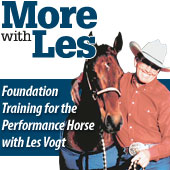 25th in a series
25th in a series
Last issue, Les reinforced communication with pattern exercises; now we’ll move to the key of a supple neck.
Objective: To begin to get your horse to give at the poll as a result of soft pressure on his mouth with both reins.
Skills You Will Develop
Timing – Timing is critical in this stage of the program. You want to make sure that you reward your horse instantly when you get the result you want so he learns to give and not pull.
Hand and leg coordination – Although we’ll spend more time working on collection in future lessons, you’ll experience more success if you use your legs and hands together to achieve vertical flexion. Make sure you’re doing it at all three gaits.
Educating your hands – Just as your horse will learn to give to the reins, you should be improving how you handle your reins. Continue to think about sliding the bit back and forth in the horse’s mouth smoothly, rather than initiating any sharp movements. Also, note what seems to work best on your horse – pay attention to what you’re doing so if the horse’s response is better or worse than before, you’re learning too. And as before, always start off with a soft cue and get stronger as you need to – as your horse progresses, he will start to respond on softer and softer cues all the time.
Why These Skills and Exercises Are Important
You’re going to hear one phrase a lot from me: “It’s in the neck!” If a horse’s neck isn’t soft and relaxed in anything you do or attempt to do, you’re just in trouble. Lateral flexion is the key to developing that soft, supple neck, and without that you really don’t have much.
You’ll need vertical flexion for your stops, for your circles, for your departures, for your turnarounds, for your lead changes, for your rollbacks … starting to understand? It IS the foundation to all great maneuvers. But don’t expect to achieve it overnight. The horse has to develop a conditioned response to readily give to the pressure of the rein, and that can take awhile, especially if you’re retraining a horse that’s been allowed to lean on the bridle in the past. You can’t just change the rules on him. You’ve got to give him a chance to unlearn the old and absorb the new, but until you’ve achieved the softness that we’re looking for, you will have limited success with the rest of the program. It’s really that important.
EDITOR’S NOTE: More with Les is a regular California Horsetrader column. Les Vogt has won more than 15 World Championships, including two wins at the NRCHA Snaffle Bit Futurity. Although Les still rides and occasionally shows, his focus is giving clinics around the world and developing products for the performance horseman. To learn more about Les and to see his clinic schedule, visit: www.lesvogt.com
Leave a Comment
All fields must be filled in to leave a message.